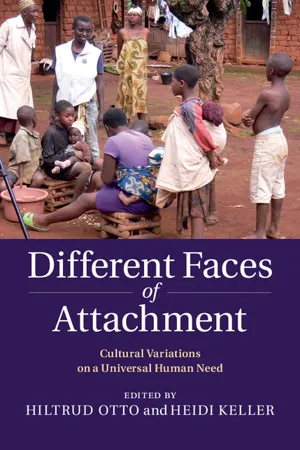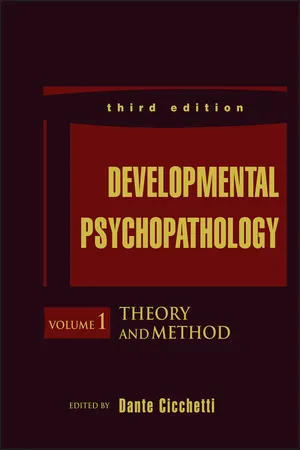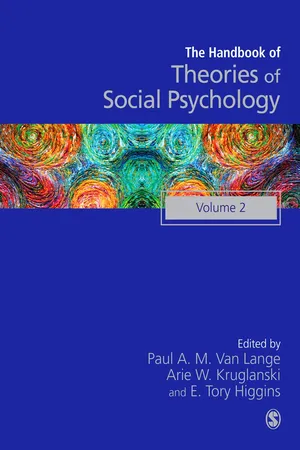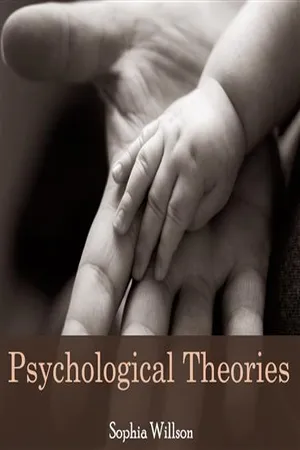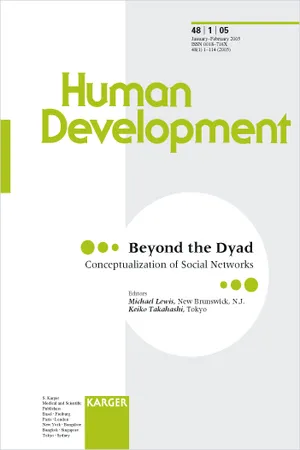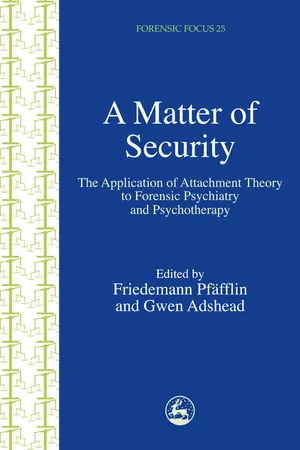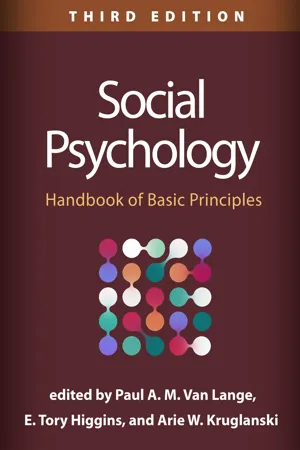Psychology
Explanations of Attachment
Explanations of attachment in psychology refer to theories and concepts that seek to understand the emotional bond between infants and their caregivers. These explanations often include the evolutionary perspective, which suggests that attachment behaviors have evolved to ensure the survival of offspring, as well as the social learning perspective, which emphasizes the role of reinforcement and modeling in the development of attachment relationships.
Written by Perlego with AI-assistance
Related key terms
1 of 5
10 Key excerpts on "Explanations of Attachment"
- eBook - PDF
Different Faces of Attachment
Cultural Variations on a Universal Human Need
- Hiltrud Otto, Heidi Keller(Authors)
- 2014(Publication Date)
- Cambridge University Press(Publisher)
Introduction: understanding relationships – what we would need to know to conceptualize attachment as the cultural solution of a universal developmental task Heidi Keller The definition of attachment as a primary bond between infants and caregivers emerging at around 1 year of age as an evolved adaptation for ensuring survival and development was the seminal contribution of the British psychiatrist and psychoanalyst John Bowlby and his (later) Canadian-American counterpart Mary Ainsworth (Ainsworth, Blehar, Waters et al., 1978; Bowlby, 1969). Attachment theory has initiated a tremendous body of research over the last decades, particularly expand- ing its focus on neurophysiological regulations, and extending it to adult- hood and clinical applications. Nevertheless, the theoretical and method- ological foundations have remained amazingly unaffected, although the basis of knowledge concerning the infant’s socioemotional development has increased substantially since the publication of Bowlby’s well-known trilogy Attachment and Loss and Ainsworth and collaborators’ summary of their empirical research on the emergence of attachment during the first year of life (1978). The first encompassing proposal for the refine- ment of conceptual and methodological issues of attachment theory and research was published by Michael Lamb and collaborators in 1984 in the renowned journal Behavioral and Brain Sciences – though without any observable notice by other attachment researchers. Attachment theory is grounded in evolutionary theory with its basic tenet that every human characteristic is shaped through selection pro- cesses and represents an adaptation to contextual demands. Bowlby stressed explicitly the contextual nature of attachment in his early writ- ings. - eBook - ePub
- Dante Cicchetti(Author)
- 2015(Publication Date)
- Wiley(Publisher)
the field of developmental psychology in the last 60 years. By characterizing the interconnections and mechanisms that mediate between early experiences in primary attachment relationships and long-term emotional adjustment across the life span, attachment theory typifies, and indeed has made major contributions to, the developmental psychopathology approach (Cicchetti & Cohen, 1995; Rutter & Sroufe, 2000). The field of attachment—although not without a host of outstanding questions, conundrums, and fruitful seams of new research—could reasonably be described as a mature discipline, having tested, confirmed or clarified many of its major theoretical assertions. The theory remains a highly influential and important way of understanding the nature of a child's tie to primary caregivers, which coherently integrates data and theory from social-developmental psychology, cognitive psychology, life span developmental psychology, evolutionary psychology, and ethology. Its relevance for understanding emotional and behavioral maladjustment, and its value as a framework for intervention and prevention, seem undeniable. In this chapter, our goal is to provide a comprehensive overview of attachment theory and research from its earliest origins to the very latest research findings, focusing on topics of most direct relevance for understanding the development of psychopathology. We begin with an overview of the historical beginnings of attachment theory and then outline the fundamental tenets of the theory. Next, we review the empirical literature on the developmental antecedents and consequences of attachment security and insecurity, exploring what is known about mediating mechanisms in the evolution of maladjustment. Next, we turn to work on adolescent and adult attachment - eBook - PDF
- Paul A M Van Lange, Arie W Kruglanski, E Tory Higgins, Paul A M Van Lange, Arie W Kruglanski, E Tory Higgins, Author(Authors)
- 2011(Publication Date)
- SAGE Publications Ltd(Publisher)
The theory deals with close relationships and their psychological foundations and consequences. It integrates insights from psychoanalytic theory; primate ethology; cognitive developmental and social cognitive psychology; theories of stress and coping; and contemporary research on per-sonality development, affect regulation, and relational interdependence. The chapter begins with an account of the origins of attachment theory during the 1960s and 1970s in the work of John Bowlby and Mary Ainsworth. We then explain how the two of us became involved with extensions of the theory in the 1980s. Next, we describe the theory itself in some detail, placing spe-cial emphasis on our version of it, which began in the work of Hazan and Shaver (1987). This version of the theory is designed for and influenced by contemporary social psychologists. We show how attachment security, grounded in responsive, supportive relationships, plays a role in personal and social issues of interest to personality-social ATTACHMENT THEORY 161 psychologists, issues such as self-esteem, person perception, interpersonal behavior, exploration and achievement, and prosocial behavior and intergroup relations. We then consider the darker side of attachment rela-tionships, which includes the defenses and personal and relational difficulties that stem from attachment insecurities. We conclude with a brief discussion of connections between attachment theory and other social psychologi-cal theories and a brief consideration of appli-cations of attachment theory and research. THE ORIGINS OF ATTACHMENT THEORY Attachment theory was originally proposed by John Bowlby, a British psychoanalyst, and was then strengthened by the theoretical, psy-chometric, and empirical contributions of Mary Ainsworth, an American developmental psychologist. - No longer available |Learn more
- (Author)
- 2014(Publication Date)
- College Publishing House(Publisher)
A fourth pattern, disorganized attachment, was identified later. In the 1980s, the theory was extended to attachment in adults. Other interactions may be construed as including components of attachment behaviour; these include peer relationships at all ages, romantic and sexual attraction and responses to the care needs of infants or the sick and elderly. In the early days of the theory, academic psychologists criticized Bowlby, and the psych-oanalytic community ostracised him for his departure from psychoanalytical tenets; however, attachment theory has since become the dominant approach to understanding early social development, and has given rise to a great surge of empirical research into the formation of children's close relationships. Later criticisms of attachment theory relate to temperament, the complexity of social relationships, and the limitations of discrete patterns for classifications. Attachment theory has been significantly modified as a result of empirical research, but the concepts have become generally accepted. Attachment theory has formed the basis of new therapies and informed existing ones, and its concepts have been used in the formulation of social and childcare policies to support the early attachment relationships of children. ______________________________ WORLD TECHNOLOGIES ______________________________ Attachment Although it is usual for the mother to be the primary attachment figure, infants will form attachments to any caregiver who is sensitive and responsive in social interactions with them. Within attachment theory, attachment means an affectional bond or tie between an individual and an attachment figure (usually a caregiver). Such bonds may be reciprocal between two adults, but between a child and a caregiver these bonds are based on the child's need for safety, security and protection, paramount in infancy and childhood. - eBook - PDF
Nurturing Attachments
Supporting Children who are Fostered or Adopted
- Kim Golding(Author)
- 2007(Publication Date)
- Jessica Kingsley Publishers(Publisher)
Part 1 Attachment Theory 1 Overview of Attachment Theory Attachment theory is a theory of child development that focuses on the influ-ence of early relationships on children. The theory suggests that the child’s subsequent development and capacity to form relationships will be influenced by this early experience. This theory therefore has important implications for children growing up in substitute care. Children who live in foster or adoptive homes all share a disruption of their early relationships, a loss of or separation from their biological families. Additionally most of these children and young people will have experienced inadequate parenting early in their lives, and many will have had to cope with multiple placements following removal from their family. Attachment theory can guide our understanding of the effects of early abuse, neglect, separation and loss on the child’s ability to form healthy attachments with new parents. It can help you to make sense of some of your child’s subse-quent behaviour. In particular the way that your child relates to you can be heavily influenced by the way he learnt to relate to birth parents. You can find yourselves caught up in interactions that are not your own. In fact a child can hold so tightly to these ways of relating that you find yourself pushed into 23 Catherine, Zoë, Marcus and Luke have all experienced difficult early home lives with neglect of their emotional and physical needs, inconsistent or unavailable parenting and, for Marcus in particular, the fear of hurt and pain from at least one of his parents. They were all removed from these families and Catherine, Zoë and Marcus experienced multiple placements before being able to settle in a more perma-nent home. The legacy of these early years is still very apparent in the difficulties they display in developing relationships with their foster or adoptive parents. - eBook - PDF
Beyond the Dyad
Conceptualization of Social Networks. Special Topic Issue: Human Development 2005, Vol. 48, No. 1-2
- Lewis, Takahashi(Authors)
- 2005(Publication Date)
- S. Karger(Publisher)
But a construct’s validity does not depend on exhaustively explaining everything it is correlated with. Indeed, constructs often lose definition and coherence when stretched to explain too much. Bowlby was well aware of this danger and intended that attachment theory remain focused on specific components of our closest rela-tionships [Bowlby, R., pers. commun.]. The Logic of Attachment Theory John Bowlby developed the modern attachment theory in order to preserve some of Freud’s key insights about the importance of early experience, close rela-tionships, and defensive processes. The key postulates of the theory replace Freud’s views of dependency and drive reduction with more modern and empirically acces-sible views of the child’s tie to its mother, motivation, and development. Specifi-cally, Bowlby viewed infants and children as far more competent and environmen-tally oriented and their relationship to primary caregivers as valuable support in their learning about their environment. He also argued that secure base excursions and retreats to safety are better explained in terms of information processing and control systems theory than drive theory. And lest they seem as magical as Freud’s drives and mental energies, he presented a closely argued case that evolution regu-larly provides socially relevant biases in species learning abilities. The final key to Bowlby’s theory is the notion that over time children construct mental representa-tions of their secure base experience. These representations are central to the expec-tation that early experience effects later development. Within this framework, attachment development is not a matter of activating some sort of genetically encoded blueprint. Instead, a behavioral control system is constructed over time when biases in our affective, cognitive, and learning abilities interact with the organization of a caregiver who acts like a secure base. - eBook - PDF
- Anne Hurry(Author)
- 2018(Publication Date)
- Routledge(Publisher)
The theory of attachment The nature of the attachment system Attachment theory, developed by John Bowlby (1969, 1973, 1980), postulates a universal human need to form close affectional bonds. It is a normative theory of how the attachment system functions 8 PETER FONAGY & MARY TARGET in all humans. Bowlby described attachment as a special type of social relationship, initially between a baby and his mother and father, involving an emotional bond. It may also be seen as the context within which the human infant learns to regulate emotion (Sroufe, 1990). The stability of early childhood attachment patterns is well demonstrated. Mary Ainsworth and her colleagues (Ainsworth, Blehar, Waters, & Wall, 1978) developed a procedure commonly known as the Strange Situation, which classifies infants and tod-dlers into one of four attachment categories, in relation to either parent. Secure babies explore readily in the presence of the par-ent, are anxious in the presence of the stranger, are distressed by the parent's departure and brief absence, rapidly seek contact with the parent following separation, and are reassured by renewed contact. The recovery from an over-aroused, distressed state is fairly rapid and smooth, and completed in that the infant returns to exploration and play. Some babies, who usually seem less anxious during the separa-tion, do not readily seek comfort and closeness to the mother or father on return and may show no preference for the caregiver over the stranger; these infants are designated Anxious / Avoidant. The Anxious/Resistant infant shows impoverished exploration and play, tends to be highly distressed by separation from the parent, but has great difficulty in settling after reunion, showing struggling, stiffness, continued crying, or more passive fussing. The parent's presence or attempts at comforting fail to offer reas-surance, and the baby's anxiety and anger appears to interfere with his attempts to gain comfort from closeness. - eBook - PDF
A Matter of Security
The Application of Attachment Theory to Forensic Psychiatry and Psychotherapy
- Friedemann Pfafflin, Gwen Adshead(Authors)
- 2003(Publication Date)
- Jessica Kingsley Publishers(Publisher)
During the ‘attachment boom’ there has been an explosion of terms relating to different theoretical constructs of attachment. A review of the recently published attachment literature abstracts from January 2000 until May 2002 revealed a multitude of terms used in a rather confusing way. In this chapter the usage of terms is discussed with respect to their core meaning, and the adequacy of their application is evaluated. In order to provide a basis for empirical comparisons, social science requires a clear and specific conceptualisation of terminology. The terms ‘attachment style’, ‘– representation’, ‘– pattern’, ‘– quality’, ‘– status’, ‘– organisation’, ‘– class/classification’, and ‘– type/prototype’ are discussed in some detail and suggestions for further usage are made. 57 INTRODUCTION In his writings about attachment John Bowlby integrated elements of psy-choanalysis, ethology, and control-and learning theory into a theory which has greatly influenced theoretical concepts of developmental psychology, clinical psychology, psychoanalysis, and psychiatry. In his works on 1. ‘at-tachment’, 2. ‘separation’, 3. ‘loss, sadness and depression’ he focused on the central role of interpersonal relationships for social development and psychological functioning throughout life (Bowlby 1969, 1973, 1980). His theoretical considerations of attachment relationships were led by one central observation: in case of perceived physiological or psychological threat or danger, children tend to preserve their psychological integrity by seeking protection with primary caregivers. He developed two major hypotheses regarding the origin of inter-individual differences of attach-ment: 1. Through a history of responsive care, children will evolve expectations (inner working models) of their caregivers’ likely responses to signs of distress or other signals of the desire for contact. - eBook - PDF
Social Psychology
Handbook of Basic Principles
- Paul A. M. Van Lange, E. Tory Higgins, Arie W. Kruglanski(Authors)
- 2020(Publication Date)
- The Guilford Press(Publisher)
Journal of Experimental Social Psychology, 39, 317–331. Sroufe, L. A. (2016). The place of attachment in de- velopment. In J. Cassidy & P. R. Shaver (Eds.), Handbook of attachment: Theory, research, and clinical applications (3rd ed., pp. 997–1011). New York: Guilford Press. Sroufe, L. A., Egeland, B., Carlson, E., & Collins, W. A. (2005). The development of the person: The Minnesota Study of Risk and Adaptation from Birth to Adulthood. New York: Guilford Press. Sroufe, L. A., & Waters, E. (1977). Attachment as an organizational construct. Child Development, 48, 1184–1199. Stern, J. A., Fraley, R. C., Jones, J. D., Gross, J. T., Shaver, P. R., & Cassidy, J. (2018). Developmental processes across the first two years of parenthood: Stability and change in adult attachment style. Developmental Psychology, 54, 975–988. Szepsenwol, O., & Simpson, J. A. (2019). Attach- ment within life history theory: An evolution- ary perspective of individual differences in at- tachment. Current Opinion in Psychology, 25, 65–70. van IJzendoorn, M. H. (1990). Developments in cross-cultural research on attachment: Some methodological notes. Human Development, 33, 3–9. van IJzendoorn, M. H., & Sagi-Schwartz, A. (2008). Cross-cultural patterns of attachment: Universal and contextual dimensions. In J. Cassidy & P. R. Shaver (Eds.), Handbook of attachment: Theory, research, and clinical applications (2nd ed., pp. 880–905). New York: Guilford Press. Waters, E., & Cummings, E. M. (2000). A secure base from which to explore close relationships. Child Development, 71, 164–172. Zeifman, D. M., & Hazan, C. (2016). Pair bonds as attachments: Mounting evidence in support of Bowlby’s hypothesis. In J. Cassidy & P. R. Shaver (Eds.), Handbook of attachment: Theo- ry, research, and clinical applications (3rd ed., pp. 416–434). New York: Guilford Press. - eBook - ePub
Attachment Theory
Social, Developmental, and Clinical Perspectives
- Susan Goldberg, Roy Muir, John Kerr, Susan Goldberg, Roy Muir, John Kerr(Authors)
- 2013(Publication Date)
- Routledge(Publisher)
constructivist vision, to which, had he conceived it in these terms, Bowlby would, I believe, have subscribed, the task of therapy is deepening existing reality, rather than replacing it with some secret truth. Transference here is, in Leven-son’s (1984, p. 266) words, “[a] slice of life, intensified yet made manageable by the constraints of the analytic frame,” with the analyst a coexplorer of a shared psychic space.Attachment Theory and Contemporary Psychoanalytic Psychotherapy
Thus far we have considered attachment theory and psychoanalysis in their social and historical context. But psychoanalysis is an autonomous discipline, with its own internal logic and preoccupations, detached–perhaps, I have argued, too detached–from such wider concerns. Yet, patients need help and understanding. I therefore turn now, albeit schematically, to the implications of attachment theory for the practice of psychotherapy, and consider four main themes: the secure base phenomenon, narrative, affect and defense, and sexuality. I conclude with a case example that illustrates some of the theoretical points.The Secure Base Phenomenon
Attachment research has shown that a school-age child’s sense of security is greatly influenced by the consistency, responsiveness, and attunement he or she experienced with his or her parents in infancy. Similar behaviors–many of them nonverbal–may influence the establishment of a secure therapeutic bond and thereby affect subsequent outcome in psychotherapy. There is firm evidence that early, positive therapeutic alliance is the best predictor of good outcome in therapies of all types and that “nonspecific factors” (i.e., not based on any one theory or practice)–usually subsumed under the Rogerian triad of empathy, nonpossessive warmth, and honesty–play a decisive role in outcome (Holmes and Iindley, 1989). Research is needed to identify the therapeutic homologues of successful maternal behaviors. For example, responsive mothers with securely attached offspring pick up their babies more rapidly and frequently than mothers of insecure children; similarly, the effective therapist “picks up” the cues of his patient and responds appropriately. In Stern’s (1985
Index pages curate the most relevant extracts from our library of academic textbooks. They’ve been created using an in-house natural language model (NLM), each adding context and meaning to key research topics.
